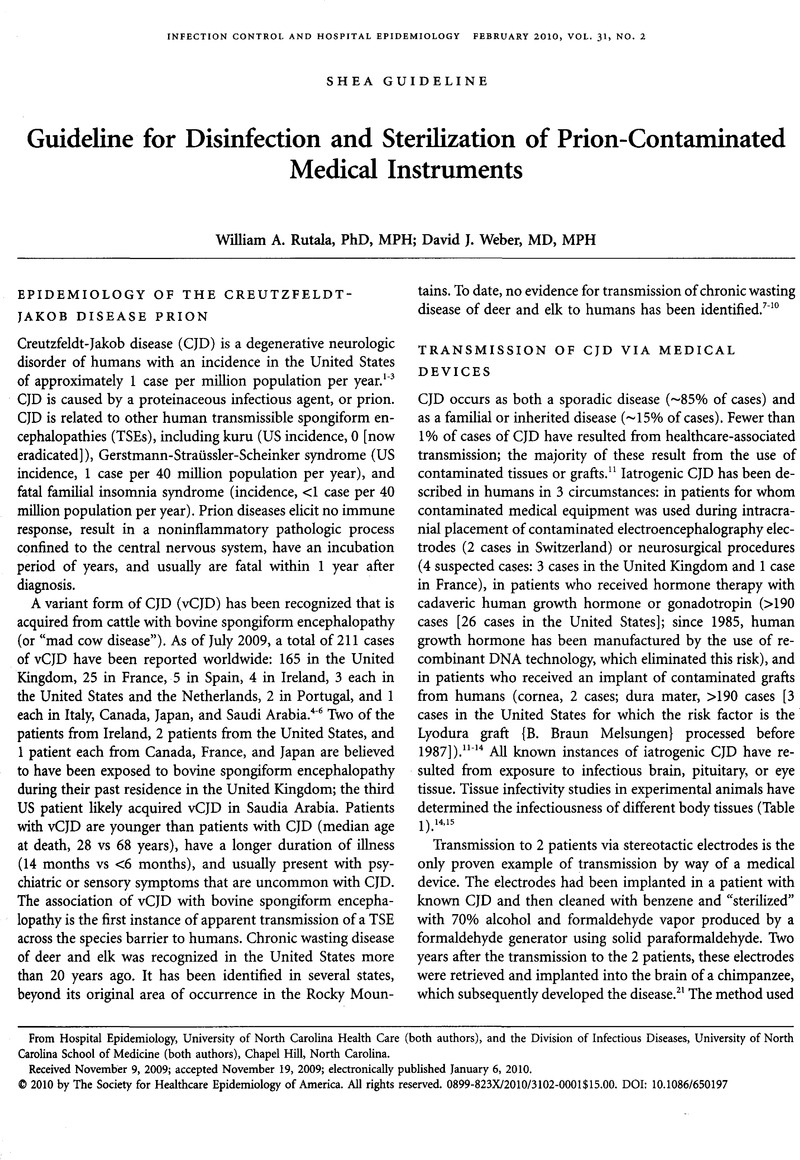Crossref Citations
This article has been cited by the following publications. This list is generated based on data provided by Crossref.
Rutala, William A.
and
Weber, David J.
2010.
Reply to Belay et al.
Infection Control & Hospital Epidemiology,
Vol. 31,
Issue. 12,
p.
1306.
Sriparkdee, C.
Rujirojindakul, P.
Pakpirom, J.
Prechawai, C.
Karnnauwakun, S.
and
Chantarokorn, A.
2010.
Contamination of intubating stylets in operating rooms.
Journal of Hospital Infection,
Vol. 75,
Issue. 4,
p.
331.
Belay, Ermias D.
Schonberger, Lawrence B.
Brown, Paul
Priola, Suzette A.
Chesebro, Bruce
Will, Robert G.
and
Asher, David M.
2010.
Disinfection and Sterilization of Prion-Contaminated Medical Instruments.
Infection Control & Hospital Epidemiology,
Vol. 31,
Issue. 12,
p.
1304.
Widmer, Andreas F.
and
Frei, Reno
2011.
Manual of Clinical Microbiology.
p.
143.
2011.
AAMI/ISO TIR22442-4:2011/(R)2016; Medical devices utilizing animal tissues and their derivatives—Part 4: Principles for elimination and/or inactivation of transmissible spongiform encephalopathy (TSE) agents and validation assays for those processes.
Goss, Linda K.
2012.
Staying up to Date on Disinfection and Sterilization Techniques.
Plastic Surgical Nursing,
Vol. 32,
Issue. 3,
p.
112.
Sleth, Jean-Christian
2012.
Lame réutilisable: épargnons la planète et notre argent.
Canadian Journal of Anesthesia/Journal canadien d'anesthésie,
Vol. 59,
Issue. 7,
p.
720.
Nystrand, R.
Pitten, F.-A.
Wille, B.
and
Girndt, M.
2012.
Patienten mit Prionenerkrankungen an der Dialyse – eine Risikobewertung.
Krankenhaus-Hygiene + Infektionsverhütung,
Vol. 34,
Issue. 3,
p.
101.
Duport, C.
and
Decousser, J.-W.
2012.
Endoscopie : gestion du risque infectieux.
EMC - Biologie Médicale,
Vol. 7,
Issue. 4,
p.
1.
Freeman, David E.
and
Auer, Jörg A.
2012.
Equine Surgery.
p.
98.
Sehulster, L.M.
2012.
Sterilisation of Biomaterials and Medical Devices.
p.
261.
Leunda, Amaya
Van Vaerenbergh, Bernadette
Baldo, Aline
Roels, Stefan
and
Herman, Philippe
2013.
Laboratory activities involving transmissible spongiform encephalopathy causing agents.
Prion,
Vol. 7,
Issue. 5,
p.
420.
Sethi, N
Kane, J
and
Condon, L
2013.
Creutzfeldt–Jakob disease and ENT.
The Journal of Laryngology & Otology,
Vol. 127,
Issue. 11,
p.
1050.
Sleth, J.C.
Servais, R.
Saizy, C.
Javitary, W.
and
Lafforgue, E.
2013.
Disposable or reusable blade in laryngoscopy: what choice in Languedoc-Roussillon, France?.
British Journal of Anaesthesia,
Vol. 110,
Issue. 4,
p.
656.
Thomas, Jonathan G.
Chenoweth, Carol E.
and
Sullivan, Stephen E.
2013.
Iatrogenic Creutzfeldt-Jakob disease via surgical instruments.
Journal of Clinical Neuroscience,
Vol. 20,
Issue. 9,
p.
1207.
Lawrence, Scott D.
and
Netland, Peter A.
2013.
Gamma-irradiated Cornea Allograft for Glaucoma Surgery.
Journal of Glaucoma,
Vol. 22,
Issue. 5,
p.
355.
Gupta, Rani
Rajput, Rinky
Sharma, Richa
and
Gupta, Namita
2013.
Biotechnological applications and prospective market of microbial keratinases.
Applied Microbiology and Biotechnology,
Vol. 97,
Issue. 23,
p.
9931.
Belay, Ermias D.
Blase, Jennifer
Sehulster, Lynne M.
Maddox, Ryan A.
and
Schonberger, Lawrence B.
2013.
Management of Neurosurgical Instruments and Patients Exposed to Creutzfeldt-Jakob Disease.
Infection Control & Hospital Epidemiology,
Vol. 34,
Issue. 12,
p.
1272.
Chung, Ting‐Ying
Ning, Ning
Chu, Jhih‐Wei
Graves, David B.
Bartis, Elliot
Joonil Seog
and
Oehrlein, Gottlieb S.
2013.
Plasma Deactivation of Endotoxic Biomolecules: Vacuum Ultraviolet Photon and Radical Beam Effects on Lipid A.
Plasma Processes and Polymers,
Vol. 10,
Issue. 2,
p.
167.
Bi, Long
Li, De-Cheng
Huang, Zhao-Song
and
Yuan, Zhi
2013.
Effects of Sodium Hydroxide, Sodium Hypochlorite, and Gaseous Hydrogen Peroxide on the Natural Properties of Cancellous Bone.
Artificial Organs,
Vol. 37,
Issue. 7,
p.
629.



